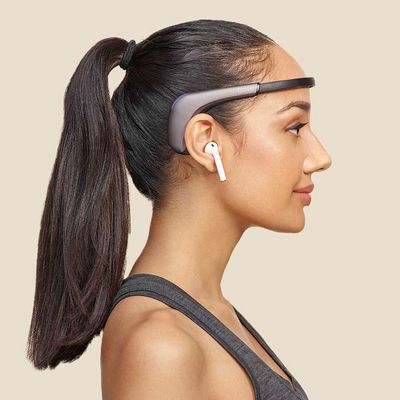
Among all of the health innovations that have landed in my in-box, nothing jumped out quite as much as “brain-sensing headband” when that email arrived in October. As someone who’s meditated on my own for years, I couldn’t not test the Muse 2 headset. If you’re familiar with the original Muse — the headband that uses EEG technology to map your brain activity — the Muse 2 is a few steps ahead. Unlike its predecessor, which only offers one mind meditation, the Muse 2 includes three more: a heart meditation, a body meditation, and a breath meditation (and by now you’ve probably heard how beneficial deep breathing is).
Here’s how it works. Via Bluetooth, you sync your headset to the Muse app on your phone and put in earbuds. Then the Muse app asks you to adjust the headset (put the ends over your ears like glasses, with the metal “brain sensing” strip flush against your forehead) while the thing calibrates by taking a snapshot of your brain. You do this before every meditation to make sure the thing is actually logging your brain activity. Every meditation starts off with easy instructions (breathing and visualizations) before you’re whisked off to a soothing nature scape.
This is where it gets good: In the “forest” environment of the mind meditation, your aim is to deep-breathe in order to calm down the chatter in your mind. A “busy mind” will create a rainstorm; a calmer mind reduces it to a lighter drizzle. You may even hear a smattering of bird song if you decrease your brain activity for an extended period of time. The body meditation is a similar game with a wind chime that’s louder when you fidget, while the breath meditation teaches you how to inhale and exhale, with an ocean wave crashing in the backdrop. The heart meditation consistently told me – through the usage of increasingly louder tribal drums, signifying a faster heart rate – that I needed to work on doing less stimulating activities (meaning fewer YouTube binges) before bedtime.
The results are often the best part. Every session ends with an invitation to log your emotions and journal in the Muse app, plus glimpse a graph of your progress. The whole experience feels like a mash-up of the Headspace meditation app and an interactive video game — plus a gratitude journal thrown in. It’s perfect for the meditation novice, and even as someone who’s been doing breath work for years, I found that the device offers something a silent savasana and guided meditation could never: a nonjudgmental companion in your ear (a rain cloud, a wind chime, okay, even the loud tribal drum) that keeps you accountable before your mind wanders too far off. I felt a lot more focused during meditations and ultimately became calmer and sleepier if I used the Muse before bed. While $250 might seem like a lot to spend at once, how much is peace of mind worth?
The Strategist is designed to surface the most useful, expert recommendations for things to buy across the vast e-commerce landscape. Some of our latest conquests include the best acne treatments, rolling luggage, pillows for side sleepers, natural anxiety remedies, and bath towels. We update links when possible, but note that deals can expire and all prices are subject to change.
Every editorial product is independently selected. If you buy something through our links, New York may earn an affiliate commission.





